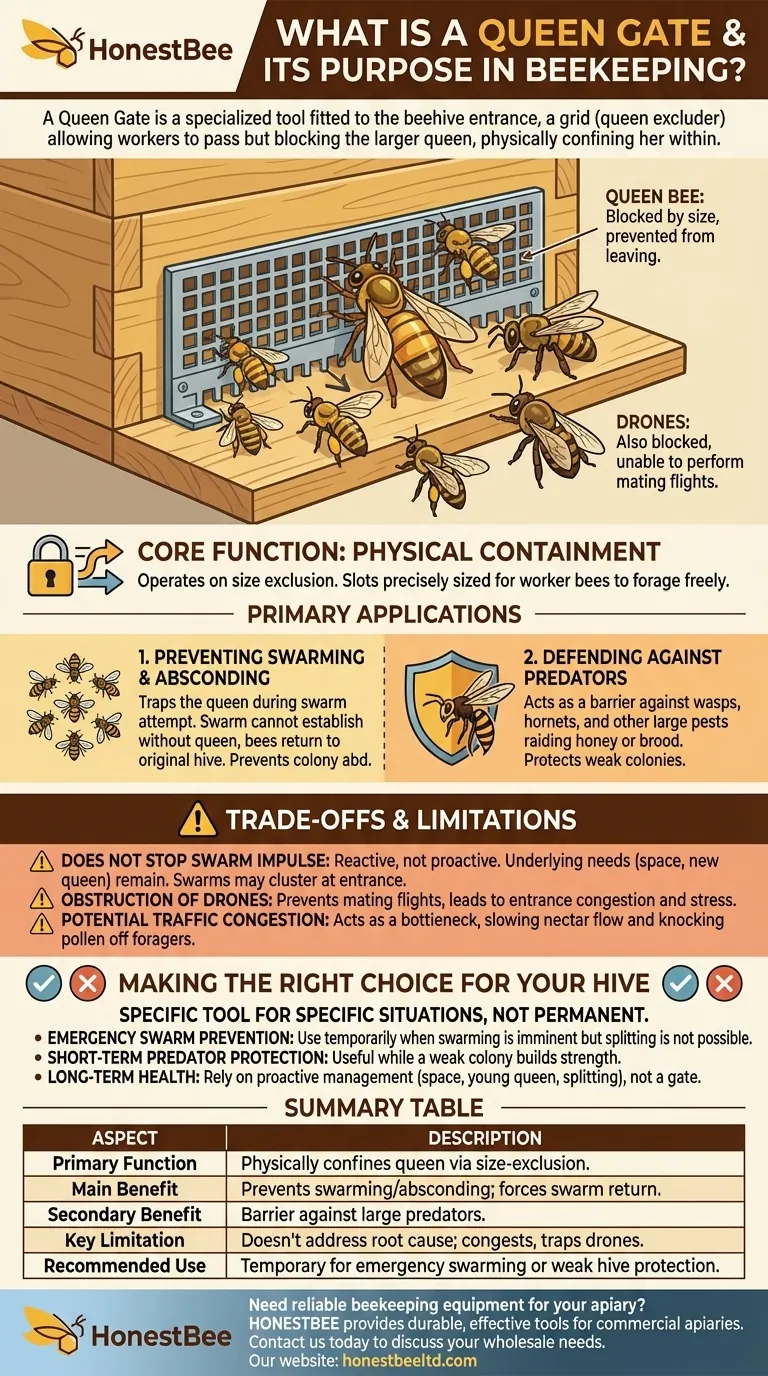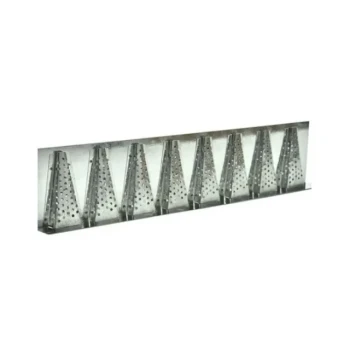In beekeeping, a Queen Gate is a specialized tool fitted to the entrance of a beehive. It is essentially a small piece of queen excluder—a grid with openings large enough for worker bees to pass through but too small for the larger queen bee. Its primary function is to physically confine the queen within the hive.
A Queen Gate is a control mechanism for the hive entrance. While it effectively prevents the queen from leaving and blocks larger predators, it is a tool that manages the symptoms of hive issues, not their root causes.

The Core Function: Physical Containment
How a Queen Gate Works
A queen gate operates on a simple principle of size exclusion. The slots or holes in the gate are precisely sized to allow smaller worker bees to enter and exit freely for foraging.
The queen bee, being significantly larger in the thorax and abdomen, cannot fit through these openings. This creates a physical barrier that ensures she remains inside the hive at all times.
Primary Applications in Beekeeping
Preventing Swarming and Absconding
The most common use for a queen gate is to prevent the loss of a colony due to swarming. When a colony decides to swarm, the old queen leaves with a large portion of the worker bees to establish a new hive.
If a queen gate is in place, the workers can exit, but the queen is trapped inside. A swarm cannot successfully establish a new home without its queen, so the bees will eventually return to the original hive.
This also prevents absconding, which is when the entire colony abandons the hive due to stress, disease, or lack of resources.
Defending Against Predators
The gate also serves as a defensive barrier against larger insects and predators. Pests like wasps or hornets, which can raid a hive for honey or brood, are often too large to pass through the excluder. This provides an added layer of protection, especially for weaker or smaller colonies that may struggle to defend their entrance.
Understanding the Trade-offs and Limitations
It Does Not Stop Swarm Impulse
A queen gate is a reactive tool, not a proactive one. It stops the queen from leaving, but it does not stop the colony's underlying instinct to swarm.
Beekeepers may find a swarm clustered at the hive entrance around the trapped queen. This indicates the colony's needs—like more space or a new queen—are not being met.
Obstruction of Drones
Drones, the male bees, are also larger than worker bees and will be trapped by a queen gate. This prevents them from performing their biological function of leaving the hive for mating flights.
A buildup of trapped drones can lead to congestion at the entrance and unnecessary stress within the colony.
Potential for Traffic Congestion
The gate acts as a bottleneck at the hive entrance. During a heavy nectar flow, it can slow the traffic of foraging bees, potentially reducing the hive's overall productivity. It can also cause pollen to be knocked off the legs of incoming foragers.
Making the Right Choice for Your Hive
A queen gate is a specific tool for specific situations, not a permanent fixture.
- If your primary focus is emergency swarm prevention: Use a queen gate temporarily when you know a hive is about to swarm but cannot perform a split immediately.
- If your primary focus is protecting a weak hive from predators: The gate can be a useful, short-term defensive measure while the colony builds its strength.
- If your primary focus is long-term hive health and productivity: Rely on proactive management like providing ample space, ensuring a young queen, and splitting strong colonies, rather than depending on a gate.
Understanding when and why to use a tool like a queen gate is key to effective and responsible beekeeping.
Summary Table:
| Aspect | Description |
|---|---|
| Primary Function | Physically confines the queen bee inside the hive using size-exclusion principles. |
| Main Benefit | Prevents swarming and absconding by trapping the queen, forcing the swarm to return. |
| Secondary Benefit | Acts as a barrier against larger predators like wasps and hornets. |
| Key Limitation | Does not address the root cause of swarming; can cause traffic congestion and trap drones. |
| Recommended Use | A temporary tool for emergency swarm prevention or short-term protection for weak hives. |
Need reliable beekeeping equipment for your apiary?
As a trusted wholesale supplier to commercial apiaries and distributors, HONESTBEE provides the durable, effective tools you need for successful hive management. From essential protective gear to advanced hive components, our products are designed to support the health of your colonies and the productivity of your operation.
Contact HONESTBEE today to discuss your wholesale needs and discover how our supplies can benefit your business.
Visual Guide

Related Products
- Beehive Entrance Reducer Guardian Metal Hive Entrance for Bees
- Multi-Functional Sliding Hive Entrance for Beekeeping
- Steel Round Disc Entrance Reducer for Flexzion Bee Hive Nuc Box Gate
- Professional Plastic Queen Excluder for Modern Beekeeping
- High Performance Plastic Queen Excluder for Beekeeping and Apiary Management
People Also Ask
- What are the different types of entrance reducers available? A Guide to Protecting Your Hive
- What size is the entrance hole in a native bee hive? The 13mm Standard for a Thriving Colony
- How can a Langstroth hive entrance be adjusted? Mimic Natural Bee Preferences for a Healthier Hive
- What are the features of the side with oblong holes in the entrance reducer? A Guide to Hive Defense & Health
- What happens if you seal an entrance to a bee hive? Avoid a Costly Structural Disaster



















